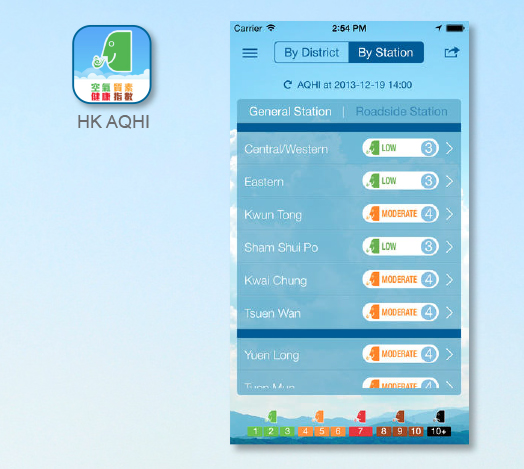
An Improved Air Pollution Alert System
The air quality may not be improving in 2014, but the government's method of reporting it most certainly has.
On 30 December 2013, a brand new Air Quality Health Index (AQHI), developed by a team led by Prof. Wong Tsz-wai of the CUHK School of Public Health and Primary Care, came into force, replacing the 20-year-old Air Pollution Index. The new AQHI monitors air quality and alerts the public to potential health risks posed by excessive exposure to four air pollutants.
Borrows from Canadian Model
Modelled on the Canadian approach but using data from Hong Kong’s public hospitals, the AQHI calculates the risks of hospital admissions for respiratory and cardiovascular diseases associated with four pollutants: sulphur dioxide, nitrogen dioxide, ozone and particulate matter of under 10 pm. The old Air Pollution Index, introduced in 1995, did not take health risks into account.
The AQHI, through its website and mobile application, reports health risk on a scale of 1 (very low) to 10+ (serious), under five categories. It gives precautionary advice to the public and vulnerable groups, including people who are active outdoors, young children, seniors, and sufferers of respiratory or heart disease. The health warnings issued are based on the concentrations of the four pollutants as recommended by the World Health Organization’s Air Quality Guidelines. In addition to the daily index, the AQHI also publishes an annual average that uses the WHO’s Air Quality Guidelines as reference. The data will be useful for the government in its efforts to reduce air pollution in the territory.

Four Pollutants

Sulphur dioxide (SO2) is present in motor vehicle emissions and may also be emitted by industries that process materials containing sulfur. Short-term exposure has been linked to wheezing, chest tightness and shortness of breath, whereas long-term exposure can lead to respiratory disease, lower the lungs' defences, and aggravate cardiovascular conditions. Sulfur dioxide and nitrogen oxides are the major contributors to acid rain.

Particulate matter (PM) are extremely small particles and liquid droplets that can include toxic organic compounds, heavy metals, dust and dirt. PM are prevalent near roadways and industries that produce a lot of dust, or formed when gases from power plants and vehicles react in the air. The size of a PM is directly linked to its potential to do damage to health. Particles which are 10 micrometers in diameter or smaller can pass through the nose and throat into the lungs, and cause serious damage to the heart and lungs.

Ozone (O3) contributes to smog and may affect the respiratory system, especially that of children, sufferers of respiratory diseases, seniors, and people who are active outdoors. Ground-level ozone interferes with plants' ability to produce and store food, compromising plant health and making them susceptible to disease, pests, and environmental stresses. The effects can accumulate over years, affecting forests and entire ecosystems.

Nitrogen dioxide (NO2) can irritate the lungs and lower resistance to respiratory infections. Sustained exposure to high concentrations may cause acute respiratory illness in children. Nitrogen oxides in the air can lead to eutrophication, the process by which a body of water becomes enriched in nutrients and is depleted of oxygen, to the detriment of fish and other marine creatures.



